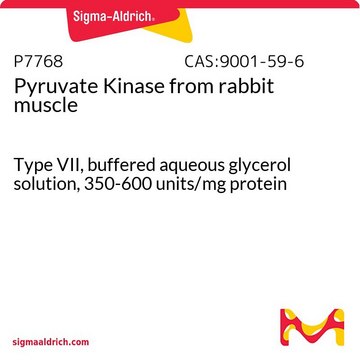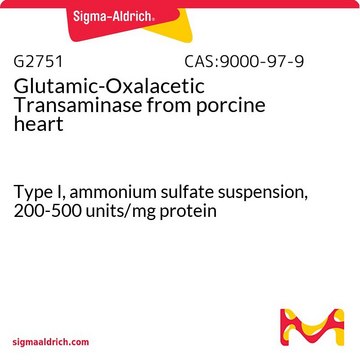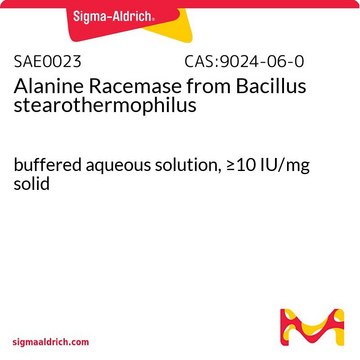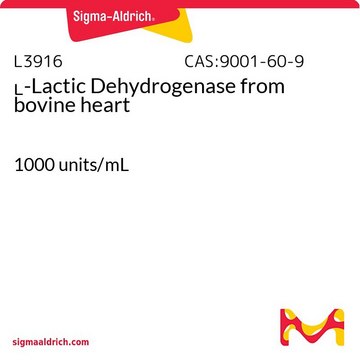L3888
D-Lactic Dehydrogenase from Lactobacillus leichmannii
lyophilized powder, 150-500 units/mg protein
Synonyme(s) :
(R)-Lactate:NAD+ oxidoreductase, D-LDH
Se connecterpour consulter vos tarifs contractuels et ceux de votre entreprise/organisme
About This Item
Produits recommandés
Source biologique
bacterial (Lactobacillus leichmannii)
Niveau de qualité
Forme
lyophilized powder
Activité spécifique
150-500 units/mg protein
Composition
Protein, ~50% biuret
Activité étrangère
Malic dehydrogenase <0.5% of base activity
Température de stockage
−20°C
Catégories apparentées
Description générale
Research area: Cell Signaling
Lactate Dehydrogenase (LDH) is classified as an oxidoreductase and is found in various organisms, including both plants and animals. LDH is widely distributed across all tissues, with high concentrations in muscle, kidney, and liver. The genes encoding LDH are LDHA, LDHB, LDHC, and LDHD. The D-isomer is produced by LDHD. There are two types of D-LDHs: NAD-dependent D-LDHs and FAD-dependent D-LDHs.
Lactate Dehydrogenase (LDH) is classified as an oxidoreductase and is found in various organisms, including both plants and animals. LDH is widely distributed across all tissues, with high concentrations in muscle, kidney, and liver. The genes encoding LDH are LDHA, LDHB, LDHC, and LDHD. The D-isomer is produced by LDHD. There are two types of D-LDHs: NAD-dependent D-LDHs and FAD-dependent D-LDHs.
Application
D-Lactic Dehydrogenase from Lactobacillus leichmannii has been used:
- in lactate dehydrogenase activity for testing the chaperone activity of proteins
- to test the kinase activities of purified thiamine monophosphate(ThiM)
- in NADH-coupled steady-state ATPase assay
- to determine cellular lactate
In the food industry, the primary catalysis is coupled to conversion of NADH and H+ to NAD+ with diaphorase coupled with converting the non-fluorescent resazurin to the highly fluorescent substance resorufin to measure the content of D-lactate in food products.
Actions biochimiques/physiologiques
D-lactic dehydrogenase catalyzes the conversion of pyruvate into D-lactate, with oxidation of NADH to NAD+. D-lactic dehydrogenase can also catalyze the reverse reaction, conversion of D-lactate into pyruvate with reduction of NAD+ to NADH.
It acts as a crucial checkpoint in gluconeogenesis and DNA metabolism. Elevated levels of LDH in the blood have been observed in various conditions, including heart attacks, cancers, liver disease, muscle trauma, anemia, bone fractures, and infections such as encephalitis, human immunodeficiency virus(HIV), and meningitis. LDH also serves as a non-specific marker of tissue turnover, which is a normal metabolic process. Additionally, reduced D-LDH activity has been found in case of mutations in LDHD found in patients with D-lactic acidosis.
Définition de l'unité
D-lactic dehydrogenase catalyzes the conversion of pyruvate into D-lactate, with oxidation of NADH to NAD+. D-lactic dehydrogenase can also catalyze the reverse reaction, conversion of D-lactate into pyruvate with reduction of NAD+ to NADH.
One unit will reduce 1.0 μmole of pyruvate to D-lactate per min at pH 7.0 at 25 °C.
Forme physique
Lyophilized powder containing phosphate buffer salts
Code de la classe de stockage
11 - Combustible Solids
Classe de danger pour l'eau (WGK)
WGK 3
Point d'éclair (°F)
Not applicable
Point d'éclair (°C)
Not applicable
Équipement de protection individuelle
Eyeshields, Gloves, type N95 (US)
Faites votre choix parmi les versions les plus récentes :
Déjà en possession de ce produit ?
Retrouvez la documentation relative aux produits que vous avez récemment achetés dans la Bibliothèque de documents.
Les clients ont également consulté
Zhaojuan Zheng et al.
Applied and environmental microbiology, 78(9), 3480-3483 (2012-02-22)
NAD-dependent l- and d-lactate dehydrogenases coexist in Lactobacillus genomes and may convert pyruvic acid into l-lactic acid and d-lactic acid, respectively. Our findings suggest that the relative catalytic efficiencies of ldhL- and ldhD-encoded products are crucial for the optical purity
Arnaud Mourier et al.
Biochimica et biophysica acta, 1777(10), 1283-1288 (2008-07-22)
Aerobically grown yeast cells express mitochondrial lactate dehydrogenases that localize to the mitochondrial inner membrane. The D-lactate dehydrogenase is a zinc-flavoprotein with high acceptor specificity for cytochrome c, that catalyzes the oxidation of D-lactate into pyruvate. In this paper, we
Andreas Neuner et al.
Biotechnology journal, 6(3), 318-329 (2011-03-04)
The Corynebacterium glutamicum ATCC 13032 lysC(fbr) strain was engineered to grow fast on racemic mixtures of lactate and to secrete lysine during growth on lactate as well as on mixtures of lactate and glucose. The wild-type C. glutamicum only grows
Takenori Shibahara et al.
Acta crystallographica. Section F, Structural biology and crystallization communications, 67(Pt 11), 1425-1427 (2011-11-22)
A dye-linked D-lactate dehydrogenase from the aerobic hyperthermophilic archaeon Aeropyrum pernix was crystallized using the hanging-drop vapour-diffusion method with polyethylene glycol 8000 as the precipitant. The crystals belonged to the monoclinic space group P2(1), with unit-cell parameters a = 63.4
Akos T Kovács et al.
Applied and environmental microbiology, 76(12), 4085-4088 (2010-04-20)
Bacillus coagulans has good potential as an industrial production organism for platform chemicals from renewable resources but has limited genetic tools available. Here, we present a targeted gene disruption system using the Cre-lox system, development of a LacZ reporter assay
Notre équipe de scientifiques dispose d'une expérience dans tous les secteurs de la recherche, notamment en sciences de la vie, science des matériaux, synthèse chimique, chromatographie, analyse et dans de nombreux autres domaines..
Contacter notre Service technique












